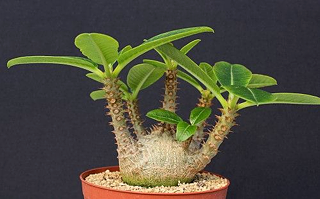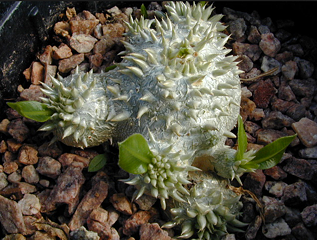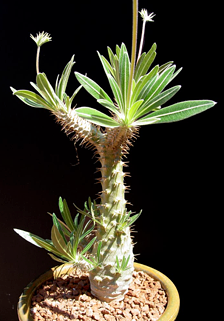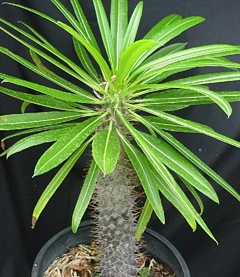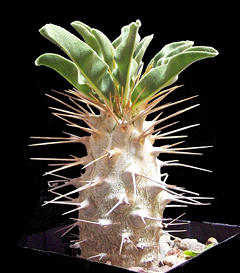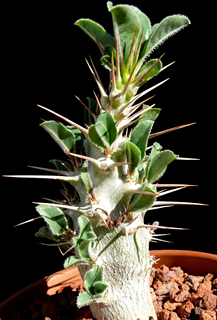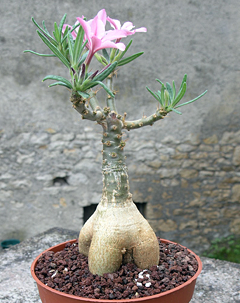Submitted by: Jim Tanner
Pachypodium are members of the Apocynaceae or Periwinkle family, and are most closely related to Adenium, and more distantly to Oleander and Plumeria. Pachypodium are native to only Southern Africa and Madagascar. There are more Madagascan species then there are African, due to the geography of the island of Madagascar, with isolated regions that encourage the development of populations of plants, animals and insects unique and isolated from others of the same genus. New species are still being discovered as botanists explore the more remote and isolated regions of Madagascar.
The Madagascan species are easy to grow, with the sole difficulty being their sensitivity to cold and wet. If they are protected, either by being brought indoors during the winter, or protected from rain and cold in a cold frame, or even a garage, they will survive and grow quickly. African species are generally easier, and are more tolerant of cold and wet.
The standard method of propagation of both the Madagascan or African species is from seed. Seeds are simply placed on good wet potting soil, and germination generally occurs within a week. Seeds should be sown in the spring to mid summer, however the seeds are generally not long lived, (germination drops off in the second or third year) and good results can be obtained nearly any time of year except mid winter. Protection from direct sun is necessary until the first few leaf pairs have formed, and then gradual movement into strong light, with an increase in feeding and water will bring quick and strong growth. Pinching of growing tips in young seedlings encourages the formation of side branches, a more interesting trunk and quicker growth.
All Pachypodiums are worth growing, and since there are not really that many species, and seedling plants are relatively cheap, a complete collection is within the resources of most.
Tom Glavich
LATIN LOOKUP – Loquerisne Latine (Do you speak Latin)?
The meanings of latin plant names on this page – from http://davesgarden.com/guides/botanary/
- baronii [bar-oh-nee-eye]
Named for Reverend Baron, an early 20th century English missionary in South Africa. - bispinosum [by-spin-OH-sum]
Two-spined. - brevicaule [brev-ee-KAW-lee, brev-ee-KAW-lay]
Short stem. - densiflorum [den-see-FLOR-um]
Densely flowered. - Lamerei [la-MER-ee-eye]
named after La Mere. - namaquanum [na-MAWK-wan-um]
Of or from the Namaqualand region (South Africa). - Pachypodium [pak-uh-PO-dee-um]
Thick foot. - saundersii [son-DER-see-eye]
Named for the botanist who discovered it in South Africa in the late 1800s. - succulentum [suk-yoo-LEN-tum]
Succulent, fleshy.
